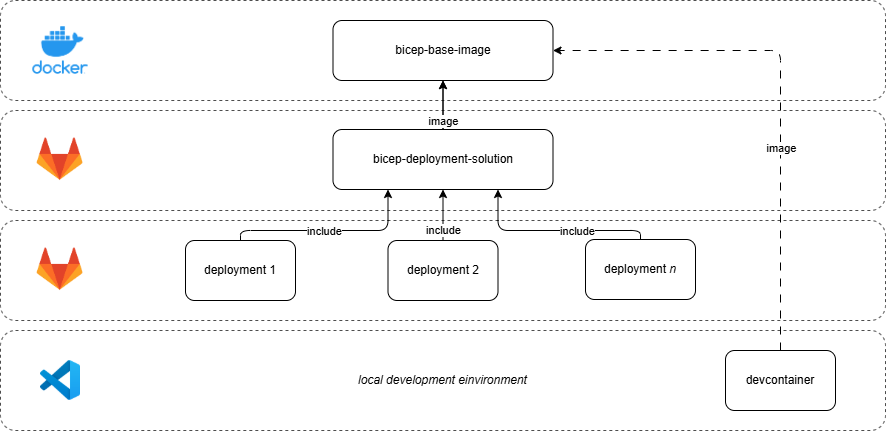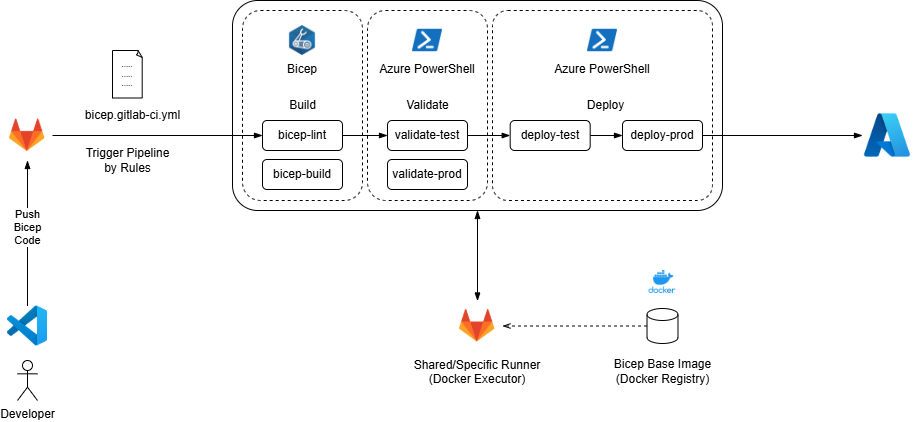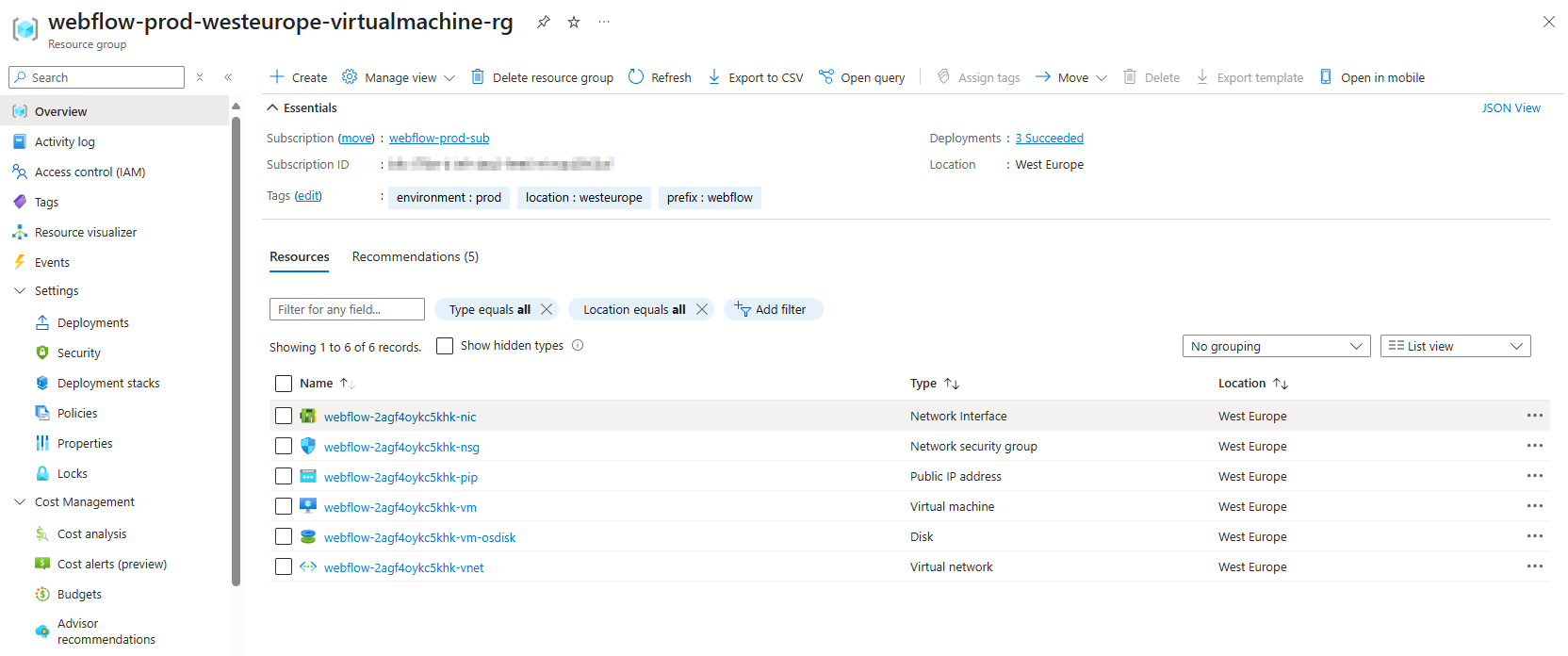Bicep Deployment Solution for GitLab
TL;DR: This guide shows how to set up a scalable, modular Bicep deployment solution using GitLab CI/CD and Docker for Azure. It covers prerequisites, pipeline structure, variables, and project setup. The solution ensures consistent, automated, and secure deployments from local development to production, leveraging reusable pipeline definitions and best practices for Infrastructure as Code (IaC).
- Overview
- Solution
- Pipeline Overview
- Prerequisites
- How-To
- Bicep Deployment
- Pipeline Variables
- Example
- Related Links
Overview
This guide describes a centralized and scalable Bicep Deployment Solution designed for efficient infrastructure deployment using Bicep, Azure Deployment Stacks, and GitLab pipelines. The solution is modular and reusable, following best practices for Infrastructure as Code (IaC).
Solution
The following image illustrates the layered architecture of the Bicep Deployment Solution:

- Docker Layer: The
bicep-base-imageprovides the foundational Docker image with all necessary tools for deployments within the pipeline or in a local dev container. - CI/CD Layer (GitLab): The
bicep-deployment-solutionbuilds on the base image and provides the centralized pipeline definitionbicep.gitlab-ci.yml. - Projects (GitLab): Individual deployments of infrastructure (e.g.,
deployment 1,deployment 2, etc.) that include the pipeline definition from thebicep-deployment-solutionand represent specific Azure deployment scenarios. - Local Development Layer: The local development environment (VS Code) uses Visual Studio Code and a dev container, leveraging the same image for consistency across environments.
Arrows labeled image indicate which Docker image the pipeline will use, while arrows labeled include show how projects include the centralized and versioned pipeline definition bicep.gitlab-ci.yml. This structure ensures modularity, reusability, and consistency from local development to cloud deployment.
bicep-base-image and the bicep-deployment-solution repositories are versioned and can be updated by a dependency bot like Renovate.
Benefits
- Declarative: Infrastructure as code for predictable, repeatable deployments.
- Clear Output: Actionable pipeline outputs for easy troubleshooting.
- Consistent & Portable: Same tools and process from local dev to production using Docker and dev containers.
- Automated & Auditable: Fast, transparent, reliable CI/CD with full change tracking in Git.
- Collaborative & Testable: Team workflows with code reviews and pre-deployment validation.
- Scalable & Integrated: Manage multiple environments with seamless GitLab, Azure, and Bicep integration.
- Secure: Built-in secrets and permissions management.
Pipeline Overview
The image illustrates a high-level overview of the CI/CD pipeline stages and their roles in automating Bicep deployments to Azure.

When a developer pushes Bicep code changes to GitLab using Visual Studio Code, the action triggers a GitLab CI pipeline defined in the bicep.gitlab-ci.yml file. This pipeline runs within a Docker-based GitLab Runner that uses the bicep-base-image to ensure a consistent environment. The pipeline first lints and builds the Bicep code, generating ARM JSON files as artifacts. These artifacts are then passed to the validation and deployment stages. The pipeline validates deployments for both test and production environments using Azure PowerShell, and upon successful validation, deploys the code as Azure deployment stacks to the respective Azure test and production environments.
Prerequisites
Before you begin, ensure you have the following:
- Active Azure subscriptions
- Access to a GitLab instance (self-hosted or gitlab.com)
- Docker installed on your local machine or CI environment
- Basic knowledge of Bicep, Azure Resource Manager (ARM), and CI/CD concepts
- Visual Studio Code
How-To
- Create two Azure Subscriptions (Test and Production Environment).
- Create an App Registration with a Client Secret. Add a Role Assignment with the
Contributorrole to your Subscriptions. - Create three new repositories on GitLab:
- Repository for the base image with the Dockerfile.
- Repository for the deployment solution.
- Repository for deploying your actual infrastructure to Azure.
Add the following GitLab CI/CD variables to your bicep-deployment-solution group in GitLab:
AZURE_TENANT_ID: Azure Active Directory Tenant IDAZURE_SUBSCRIPTION_TEST_ID: Test Azure Subscription IDAZURE_SUBSCRIPTION_PROD_ID: Production Azure Subscription IDAZURE_APPLICATION_ID: Azure App Registration (Client) IDAZURE_CLIENT_SECRET: Azure App Registration Secret (Masked/Secret)
NOTE:
For large-scale environments and improved security, it is recommended to use your own GitLab Runner infrastructure with Kubernetes. For each purpose, use a different service principal without client secrets, or use managed identities and assign permissions directly via RBAC.
Bicep Deployment
To use the deployment solution, include the bicep.gitlab-ci.yml file in your project, specifying the correct version ref.
1
2
3
4
include:
- project: 'YOUR_BICEP_DEPLOYMENT_SOLUTION_PATH'
file: 'bicep.gitlab-ci.yml'
ref: '1.0.xx'
Here is the required file structure for your projects.
│ .gitignore
│ .gitlab-ci.yml
│ README.md
├───.devcontainer
│ devcontainer.json
├───config
│ main-dev-westeurope.bicepparam
│ main-prod-westeurope.bicepparam
│ main-test-westeurope.bicepparam
└───src
│ main.bicep
└───modules
tags.bicep
virtualmachine.bicep
Pipeline Variables
Below are key variables defined in the bicep-deployment-solution pipeline. Adjust them to fit your Azure environment and project requirements.
NOTE:
For example, if you want to deploy to another region, you can set theAZURE_LOCATIONvariable toswitzerlandnorth.
Make sure there is an appropriate.bicepparamfile in theconfigdirectory of the project.
1
2
3
4
5
6
7
8
9
10
11
variables:
AZURE_LOCATION: "westeurope"
AZURE_DEPLOYMENT_NAME: "bicep-${ENVIRONMENT}-${AZURE_LOCATION}-deployment"
BICEP_SOURCE_DIR: "./src"
BICEP_MAIN_FILE: "./src/main.bicep"
BICEP_PARAMETERS_DIR: "./config"
ARM_OUTPUT_DIR: "./artifacts"
ARM_TEMPLATE_FILE: "./artifacts/main.json"
ARM_PARAMETERS_FILE: "./artifacts/main-${ENVIRONMENT}-${AZURE_LOCATION}.parameters.json"
DENY_SETTINGS_MODE: "None"
ACTION_ON_UNMANAGE: "DeleteAll"
Example
A complete example project demonstrating the Bicep Deployment Solution, including pipeline configuration and sample infrastructure code, is available in the following repository:
Results
This is how my example looks on Azure.
Related Links
- Docker - Documentation
- GitLab - CI/CD Documentation
- Microsoft - Azure Deployment Stacks
- Microsoft - Bicep Documentation
- Microsoft - Infrastructure as Code (IaC) Concepts
- Microsoft - Developing inside a Container
- Paul Hammant - Trunk-Based Development
For more details or questions, feel free to reach out or open an issue in the repository.



